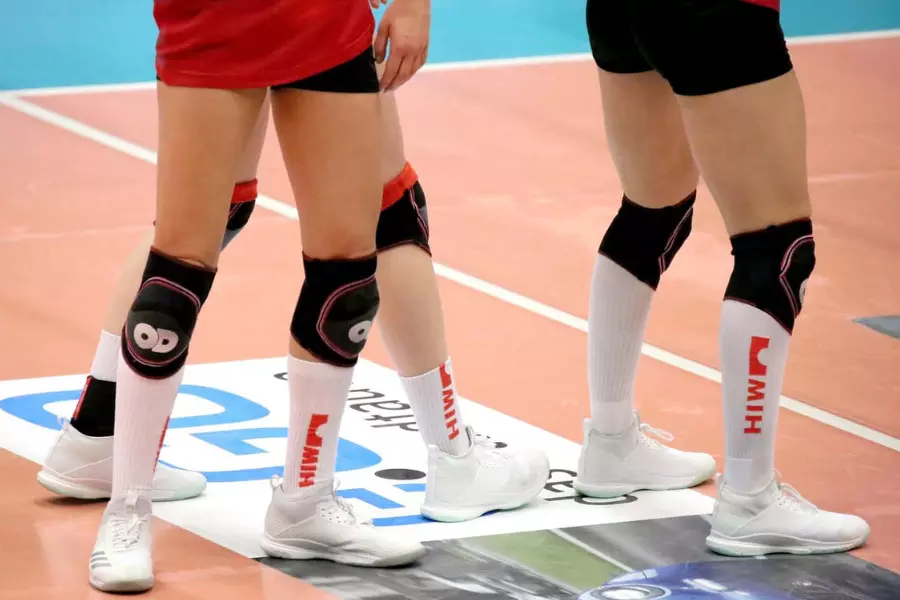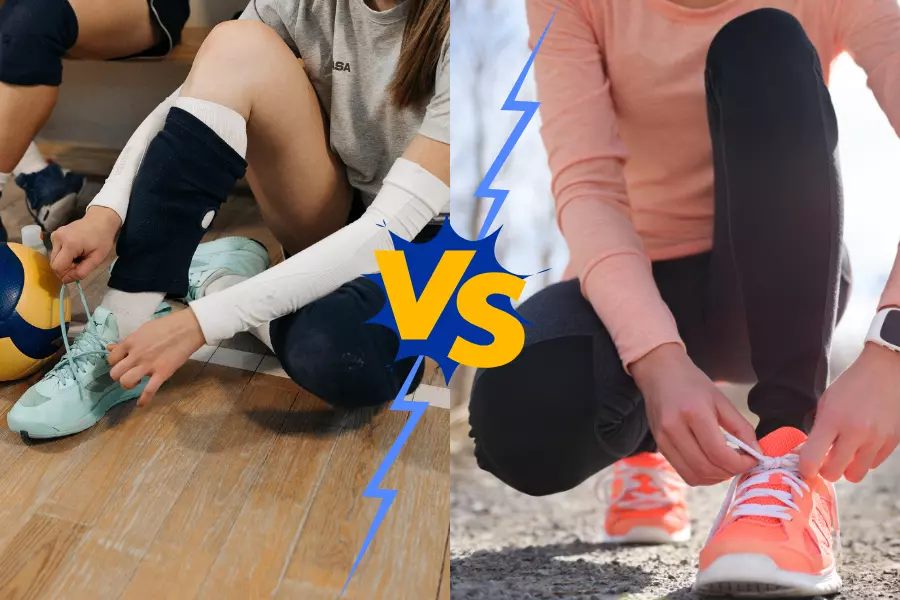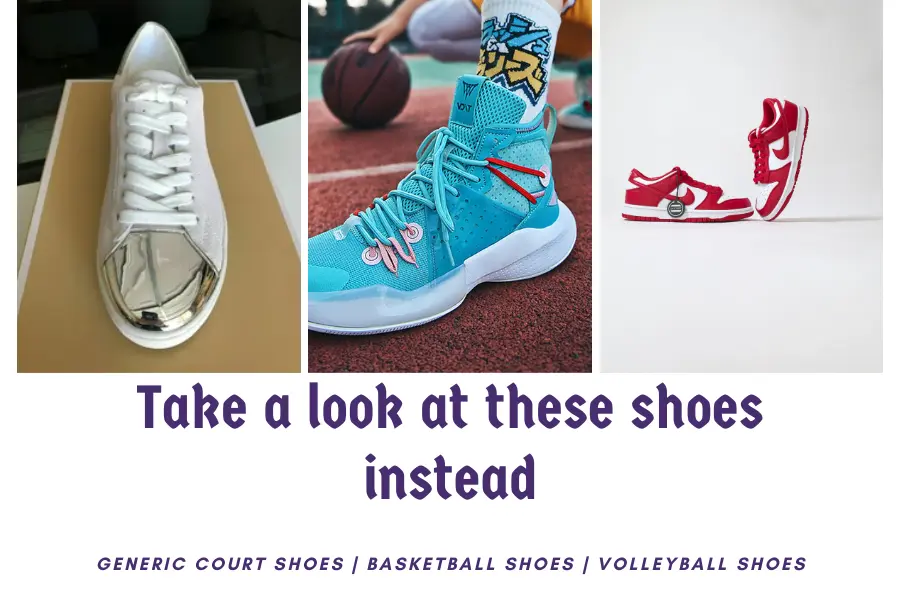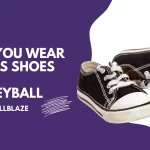If you’ve ever stepped onto a volleyball court, you know that quick movements, explosive jumps, and rapid changes in direction are all part of the game. With these dynamic demands in mind, one might wonder Are Running Shoes Good For Volleyball?
Are you able to wear those old running shoes to volleyball practice? A new pair of volleyball shoes costs a lot of money, so is it worth it?
It is simply not a good idea to play volleyball in running shoes due to their lack of lateral support, traction, and cushioning.
Accordingly, depending on the type and condition of your running shoes, you may be able to wear them occasionally for volleyball.
Investing in a solid pair of volleyball shoes, however, if you play volleyball regularly, is a really smart idea.
So you can better understand the importance of volleyball shoes, I will explain the exact reason why running shoes will eventually cause problems on the volleyball court.
Why Running Shoes Are Not Good For Volleyball

Shoes designed for running have a completely different purpose than those designed for volleyball.
Their completely different characteristics make them inefficient when used interchangeably because of their completely different characteristics.
I’ll explain why running shoes aren’t perfect for volleyball in the following paragraphs.
A lack of lateral support
Runner’s shoes are constructed with an upper material that is very thin, lightweight, and breathable. This material promotes flexibility throughout the forefoot.
As a result, they’re almost always low-top designs, which makes them lightweight.
As running is largely a safe, repetitive activity, running shoes generally don’t emphasize lateral stability much.
In volleyball, rapid lateral movements and quick changes of direction are required, as well as a lot of jumping.
Because of this, volleyball shoes usually feature reinforced/padded sides which increase their lateral stability and containment, preventing ankle rolls.
This protection around the ankles is increased by many volleyball shoes becoming mid-tops.
The fear of planting your foot awkwardly and rolling your ankle is constant when you play volleyball in running shoes.
It inhibits your ability to perform confidently, powerfully, and precisely.
Due to the thicker material on the outsides of the midsole, volleyball shoes provide a much greater sense of stability and support.
By doing so, greater safety, greater confidence, and greater performance will be achieved.
Traction is poor
Also, the outsoles of volleyball shoes differ quite a bit from those of running shoes.
There are different kinds of outsoles for running shoes, such as carbon rubber outsoles that are highly durable and designed to withstand outdoor weather conditions.
Gum rubber is usually used in volleyball shoe outsoles, which are designed to stick to volleyball courts.
It can be dangerous to play volleyball with running shoes due to how hard the outsoles are.
A lack of cushioning
A volleyball shoe’s cushioning system is also slightly better than a running shoe’s.
A jumper’s need for shock absorption and impact protection when jumping and landing is much greater than that of a runner, who requires less.
Running shoes are not the best choice if you intend to play volleyball for long periods of time.
A chronic overuse injury like a jumper’s knee may result in this in the long run.
Is it really that important?
My view is that the dose is what makes the poison.
Running shoes won’t bother you if you only wear them occasionally or for a few weeks as part of a gym class.
Unless you have a pair of volleyball shoes, you’ll be disadvantaged if you’re on a volleyball team or train/play multiple times a week.
In volleyball shoes, it’s totally different, but it’s also more dangerous as well as more uncomfortable to play in running shoes.
Also, read What is a Kill in Volleyball
Running Shoes VS Volleyball Shoes – Key Differences

There are some differences between running shoes and volleyball shoes that cater to the demands of each sport. In this quick comparison, we’ll examine some of the most important features of footwear:
Traction and grip of the sole
The sole grip and traction of your footwear are crucial factors when playing volleyball.
In volleyball, players must move quickly and agilely, stop suddenly, and change directions rapidly. It is therefore imperative that the court has excellent traction. Indoor court surfaces are usually well gripped by gum rubber soles found on volleyball shoes.
Furthermore, running shoes are designed for forward motions, so they may not provide enough grip and traction for volleyball. You can lose balance or slip if you have poor traction, which ultimately affects your performance.
Cushioning And Shock Absorption
In addition to cushioning, shock absorption is another crucial element to consider.
It is common for volleyball players to move abruptly and jump high, as well as stop quickly. In contrast, running shoes may not provide sufficient cushioning for absorbing the stresses on knees, joints, and backs.
Shoes designed for volleyball courts often have gel or air cushioning, while running shoes are designed to move forward and not jump or move laterally quickly.
Running shoes may increase an athlete’s risk of injury and discomfort when playing volleyball.
Stability And Lateral Support
Volleyball demands frequent lateral movements and quick direction changes, so lateral support and stability are crucial. It is important for volleyball shoes to provide excellent lateral support by incorporating a higher collar and stiffer materials to provide foot stability during fast movements.
Conversely, running shoes are designed to support forward motion, not lateral movements. You may suffer ankle injuries or perform poorly on the court as a result of this lack of support.
In conclusion, volleyball shoes provide optimal support and stability but are not suitable for casual play.
Responsiveness and flexibility
It is also important to consider flexibility and responsiveness when asking, “Are running shoes good for volleyball? ” Flexibility and responsiveness are two important factors when choosing volleyball shoes.
It takes quick reactions and quick movements to play volleyball on the court. A volleyball shoe’s flexibility allows it to be more agile and allows quick changes of direction.
Running shoes, on the other hand, focus exclusively on providing stability and support during forward motion. In other words, running shoes may provide a more comfortable long-term wearing experience, but they may not provide the same level of flexibility needed for volleyball games.
Also, read What Is a Setter in Volleyball
Other Shoes To Avoid Wearing On The Volleyball Court
While most of these go without saying, I have seen some pretty crazy volleyball kicks over the years!
- Toe shoes/barefoot shoes: They don’t provide much cushioning or impact protection on a hard court.
- Boxing shoes: While boxing shoes have a lot of ankle support, they lack the cushioning and stability necessary for jumping and quick lateral movements. A volleyball shoe provides much better traction than a tennis shoe.
- Vans: Basically any shoe that has a very flat outsole and a completely rounded heel. Having a rough heel-toe transition makes these shoes horrible to jump in because they ‘slap’ on the court.
Take a look at these shoes instead

You should place running shoes at the bottom of your list of possible athletic shoes to wear on a volleyball court.
If you want to have a much better volleyball experience, you don’t need volleyball shoes, but you definitely need to avoid running shoes!
Generic Court Shoes
Volleyball shoes will generally work well with any court shoe.
Tennis shoes, badminton shoes, and handball shoes are included in this category.
Although none of these shoes offer adequate impact protection, they do at least have decent overall lateral support, solid traction, and responsiveness.
Basketball Shoes
Compared to volleyball shoes, basketball shoes tend to have better cushioning systems, which is why I prefer to wear them for volleyball.
There are a lot of similarities between basketball shoes and volleyball shoes.
As a volleyball, it is usually much easier to find something very specific to your needs since the basketball shoe market is extremely large.
See my article about the best volleyball basketball shoes in 2023!
Volleyball Shoes
Volleyball shoes are not a huge market, but there are some excellent shoes that are specially designed for the sport.
As you get used to these shoes, you’ll notice they have higher tops and more advanced cushioning.
Take a look at 2023’s top-ranked volleyball shoes if you’re due for a new pair!
Frequently Asked Questions
Can I use my volleyball shoes for running as well?
As a result of differences in support, cushioning, and traction, volleyball shoes may cause injury risks and decrease performance when used for running.
To maximize performance and prevent injury, it is recommended to wear shoes designed specifically for the activity.
How often should I replace my volleyball shoes?
If you notice signs of wear on your volleyball shoes, replace them every six months or sooner.
Having the right fit is crucial to preventing injuries and enhancing agility.
Can I wear barefoot shoes for volleyball?
Natural feel and improved balance are provided by barefoot shoes, but protection and support are lacking.
Merrell Trail Gloves and Vibram FiveFingers are recommended brands for volleyball.
Volleyball is not suitable for running shoes because of their design.
Should I choose lightweight or heavy volleyball shoes?
Up to 3% of your vertical jump can be improved by wearing lighter volleyball shoes.
Shoes that are lightweight are more agile and fast, while those that are heavier are more stable.
Both types should be broken down using proper techniques.
Can I wear my indoor volleyball shoes for outdoor games?
Since outdoor volleyball shoes are durable on rough surfaces, they are the best choice for outdoor games.
It is recommended to avoid wearing indoor volleyball shoes outside as they are not designed to be worn outdoors.
Conclusion
Running shoes are not recommended for volleyball, even though they might look great for a game of volleyball.
Running shoes and volleyball shoes serve distinct purposes and have differences that cater to the specific needs of each sport. Shoes that are not the right fit can lead to injuries that could have been prevented.
It is important to consider support, stability, and traction when choosing volleyball-specific shoes.
Moreover, read more here about Volleyball Setter Workouts





